
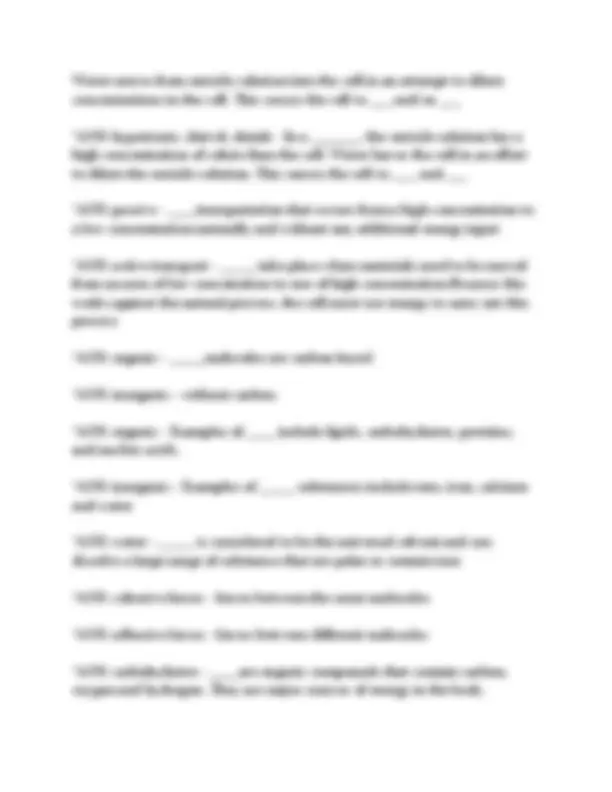
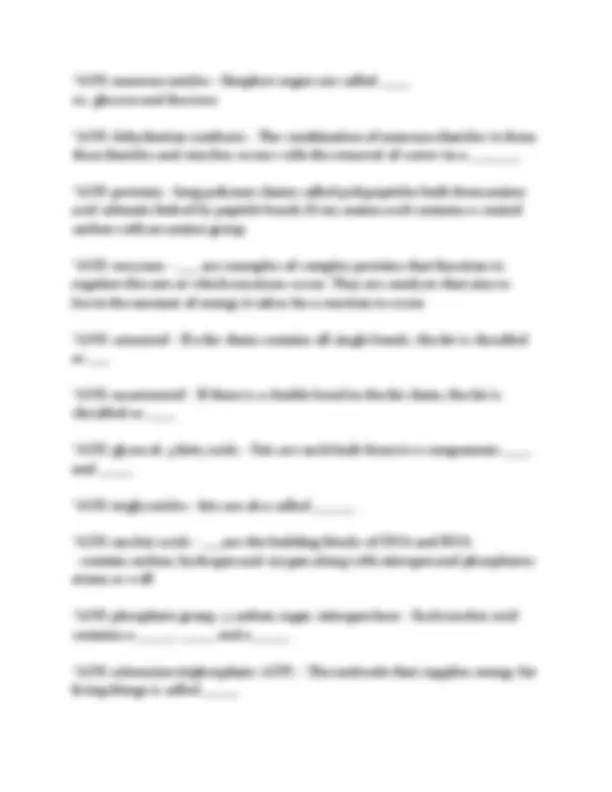
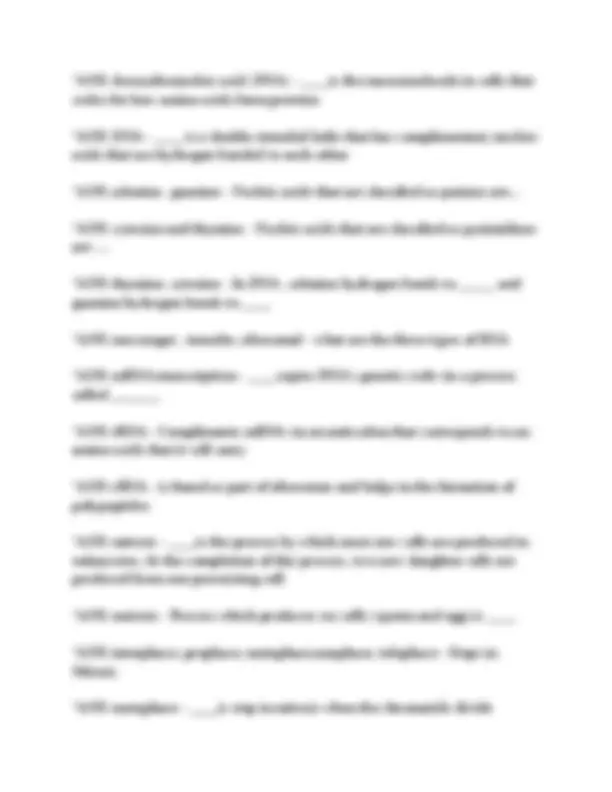
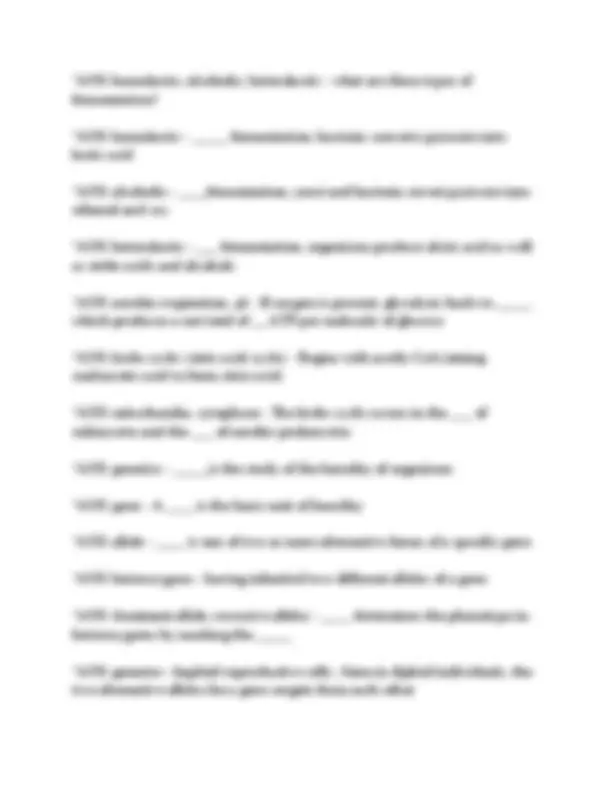
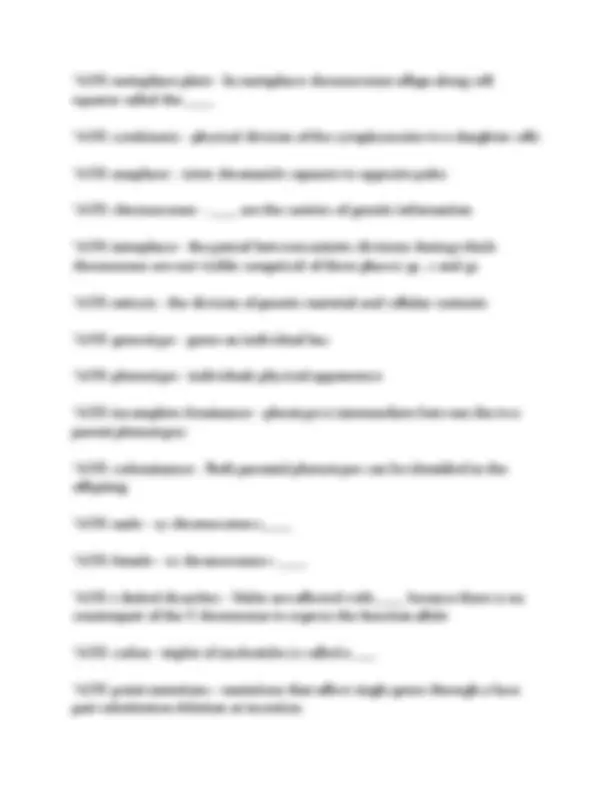
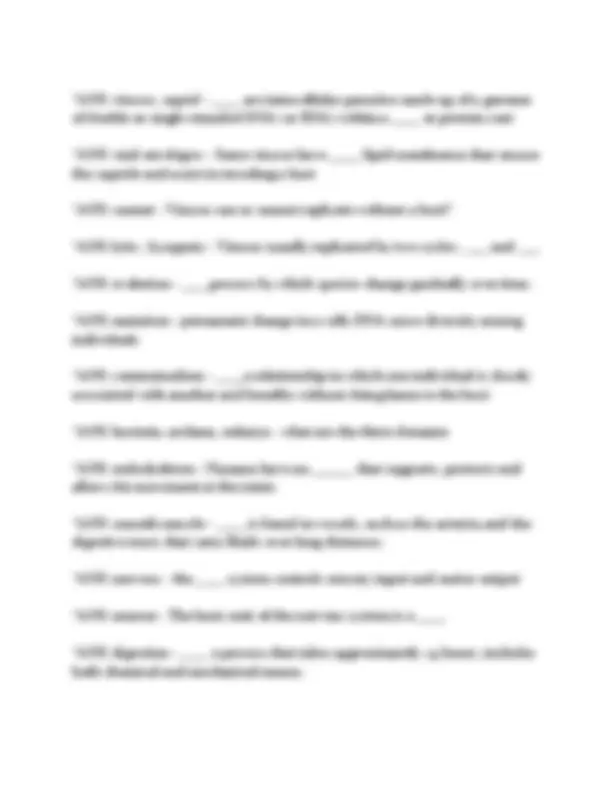
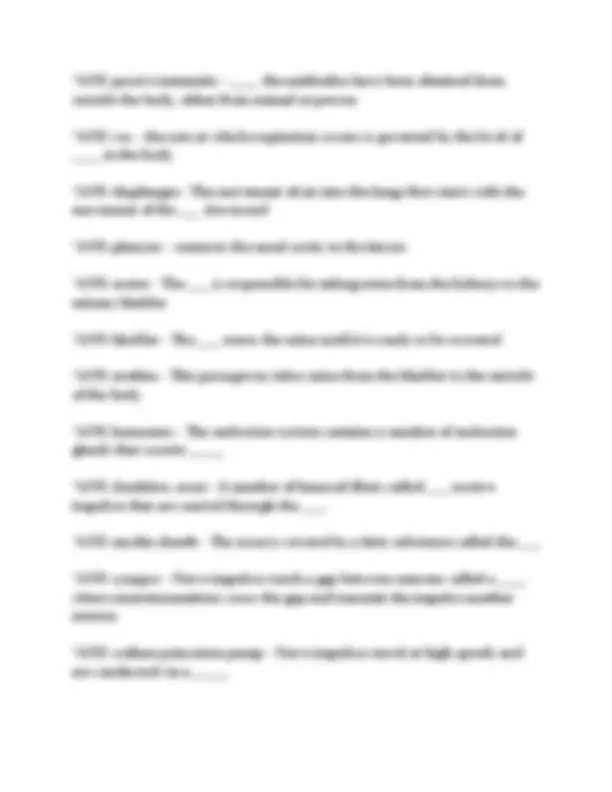
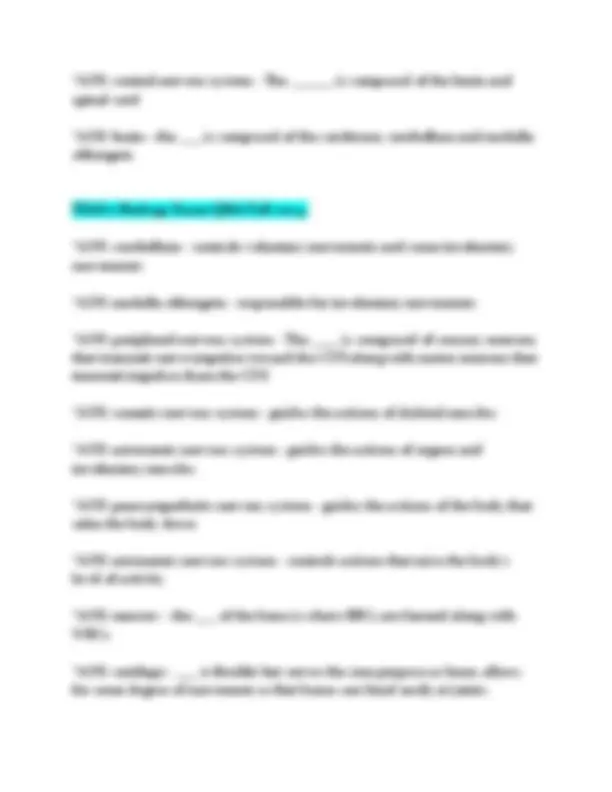
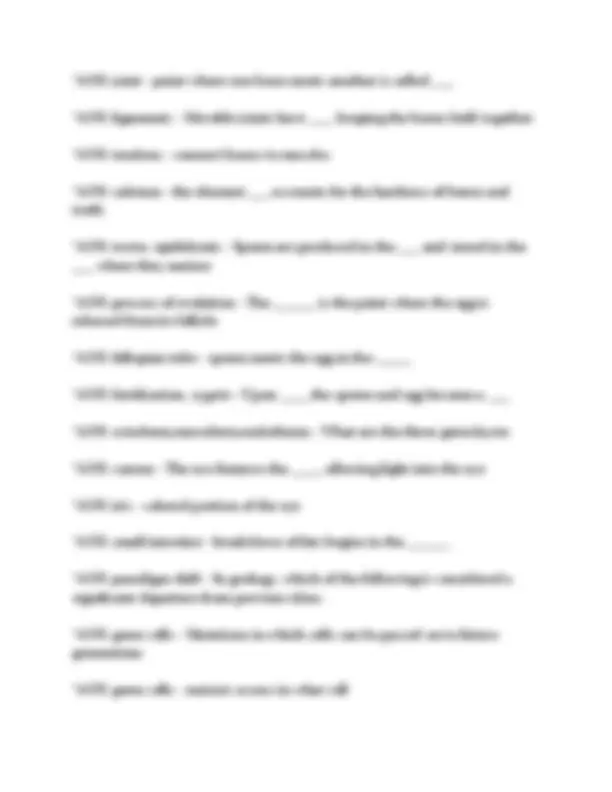
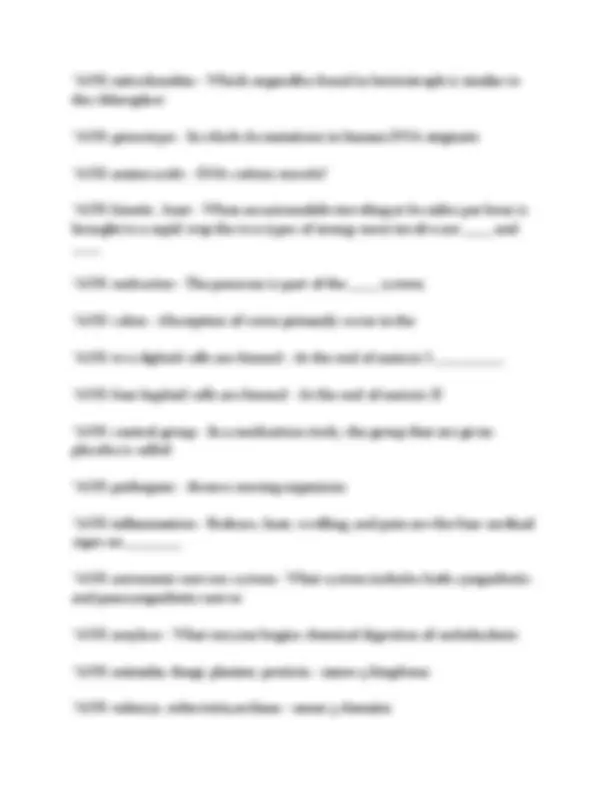
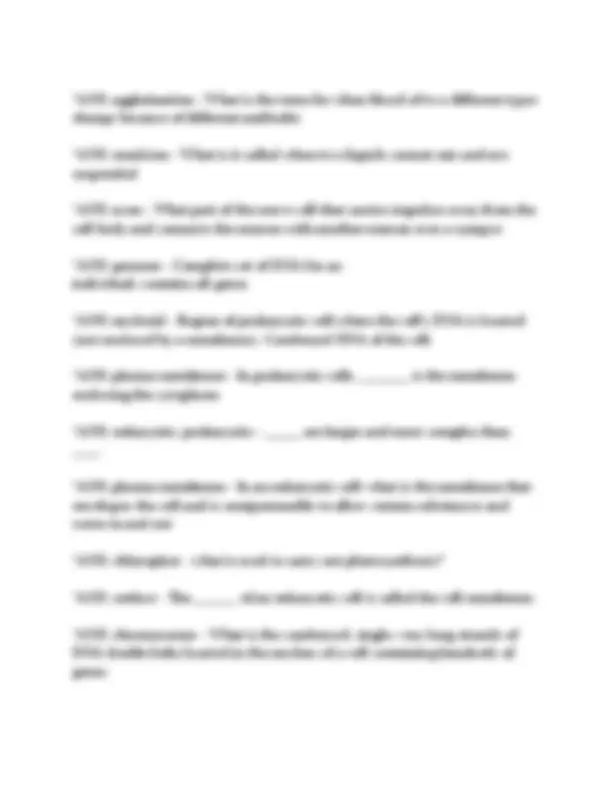
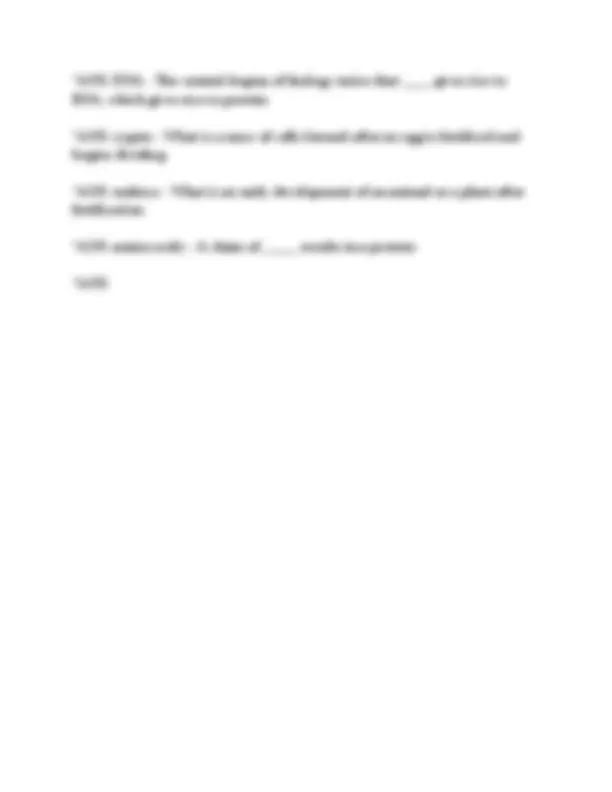
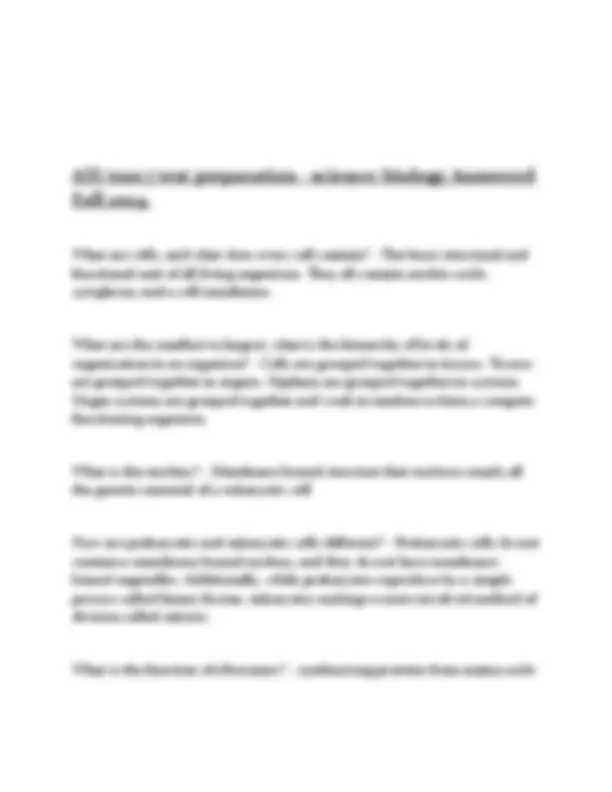
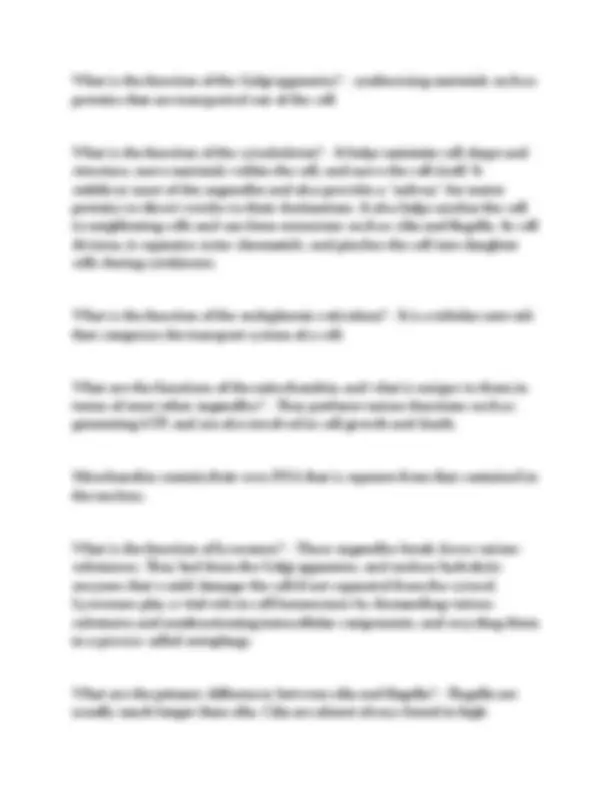
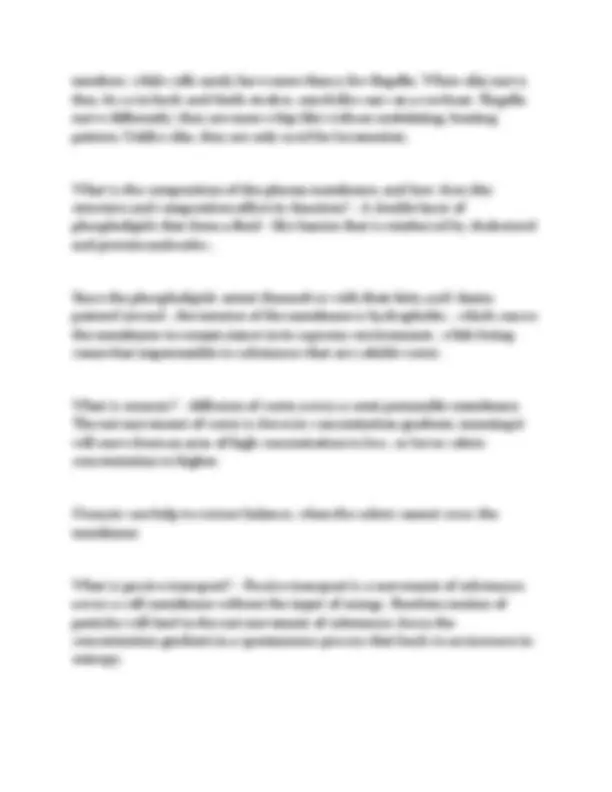
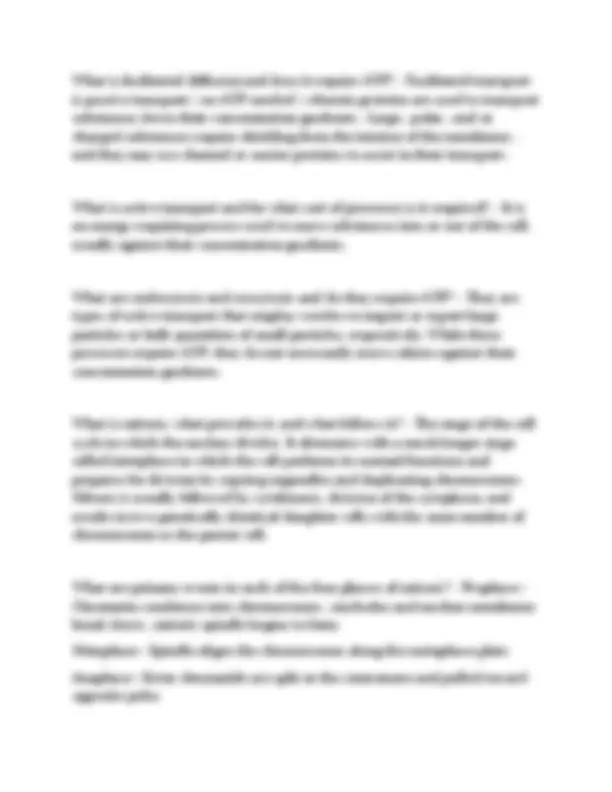
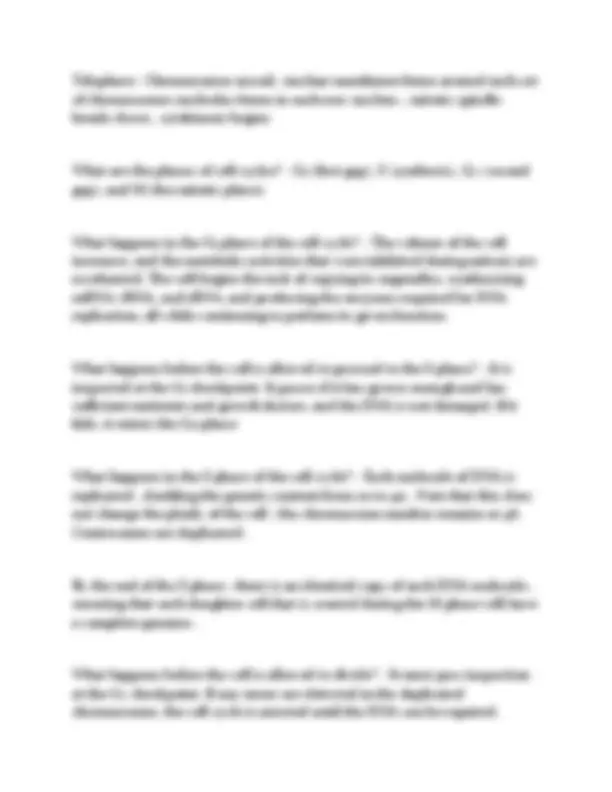
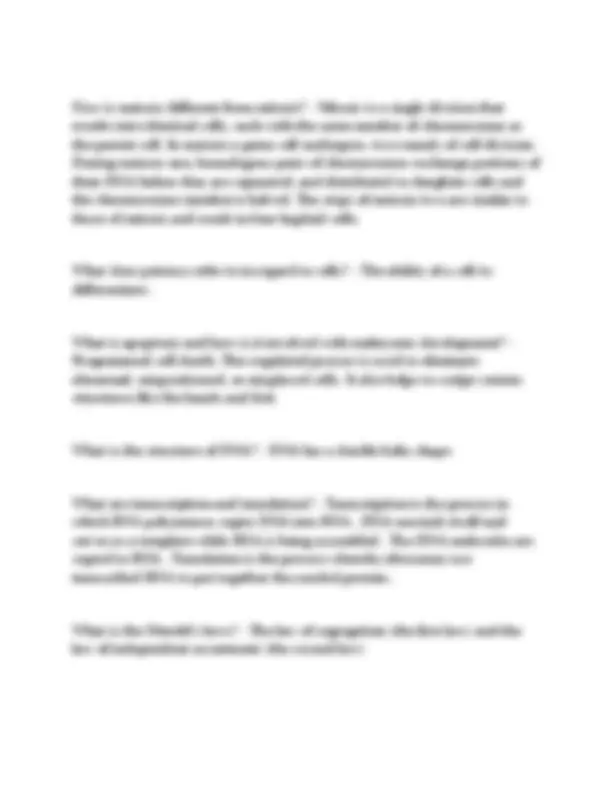
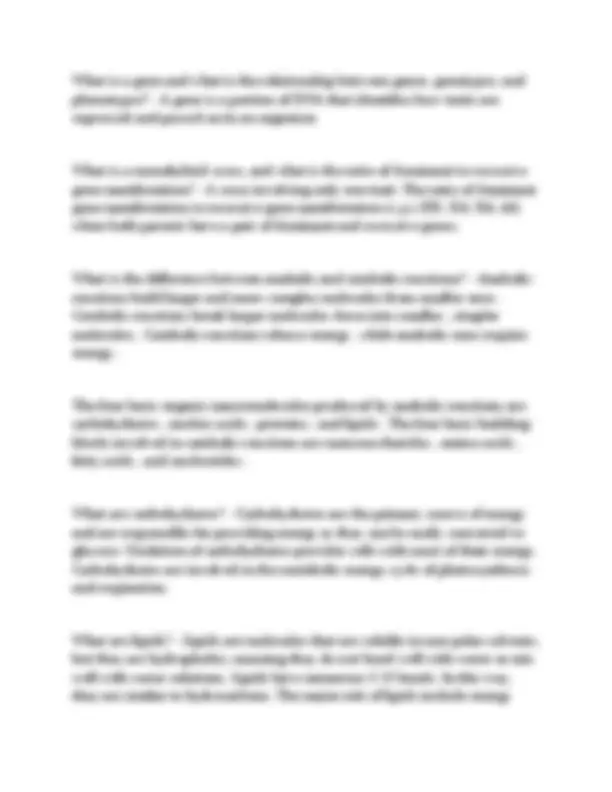
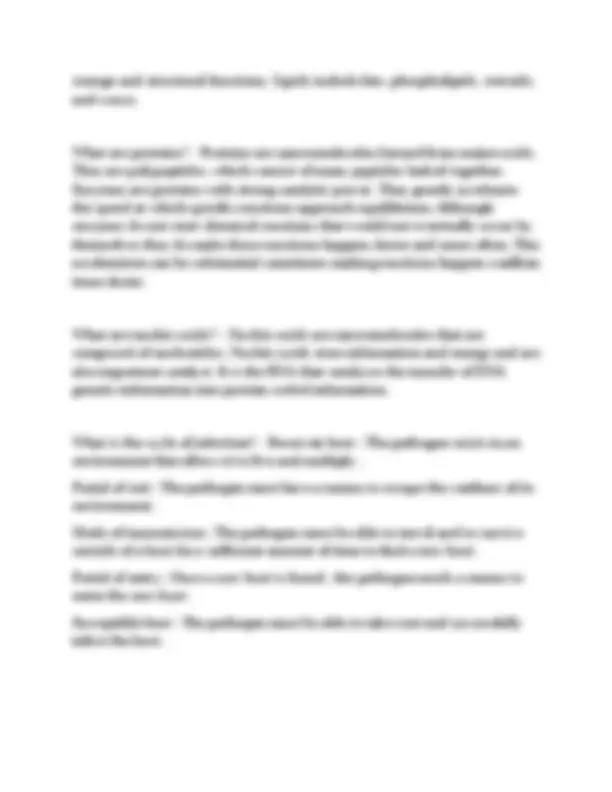
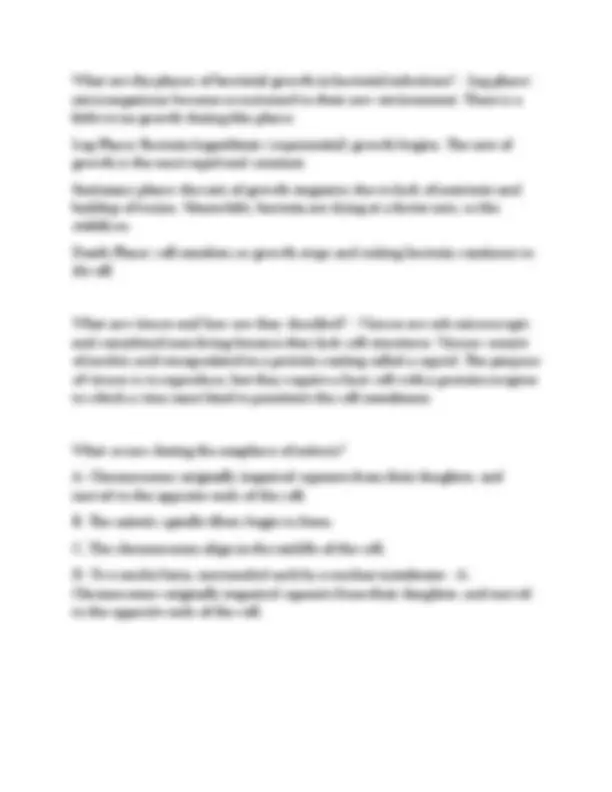
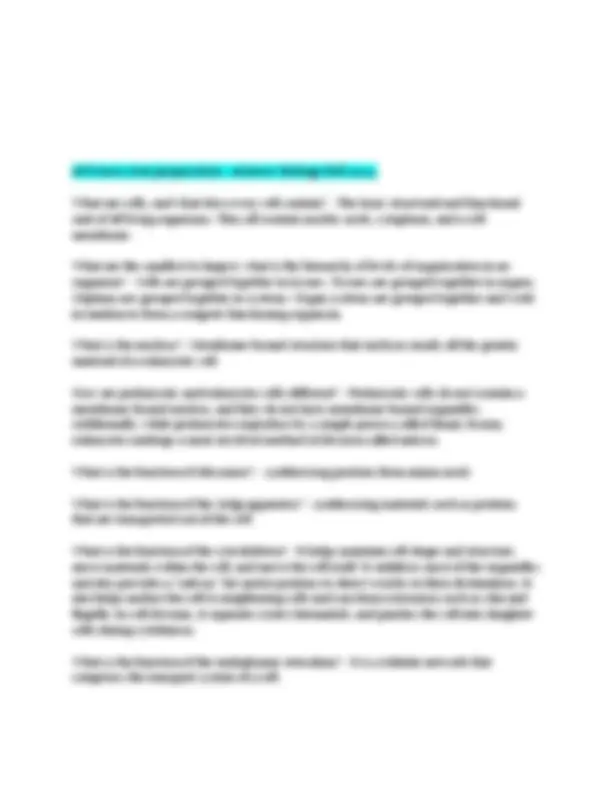
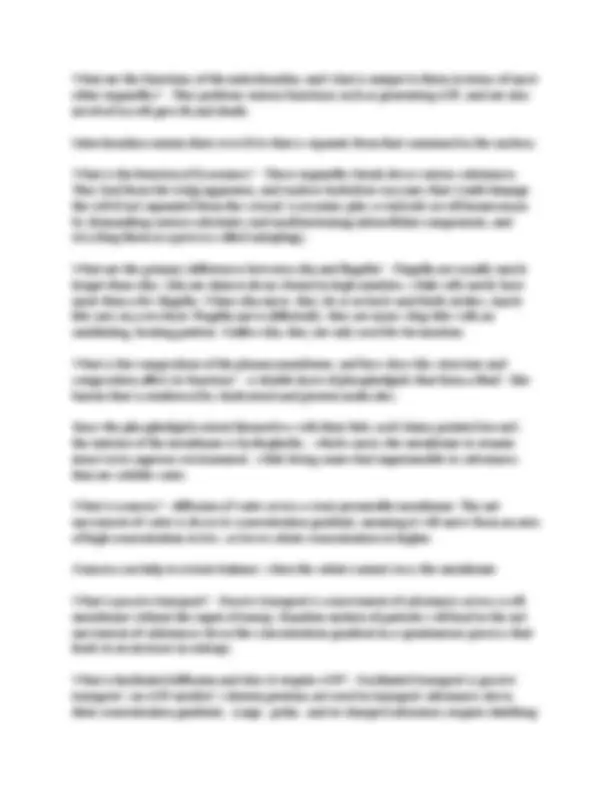
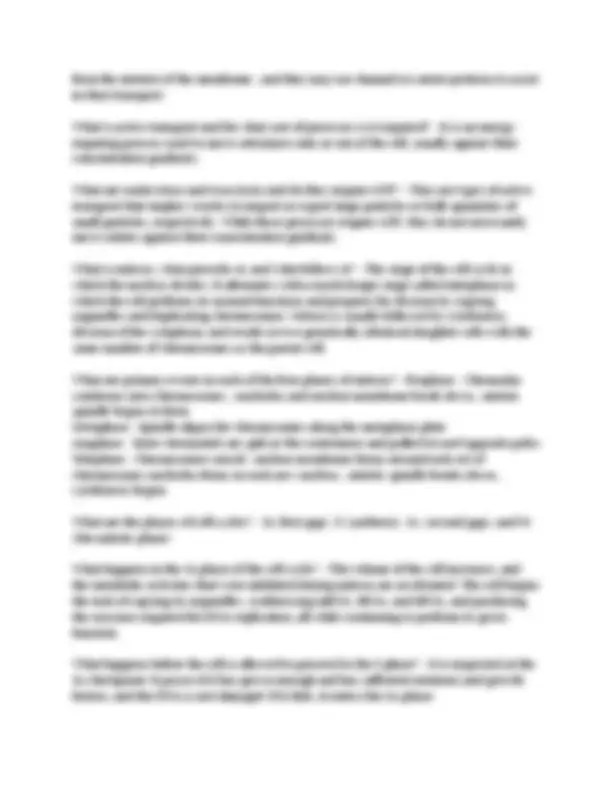
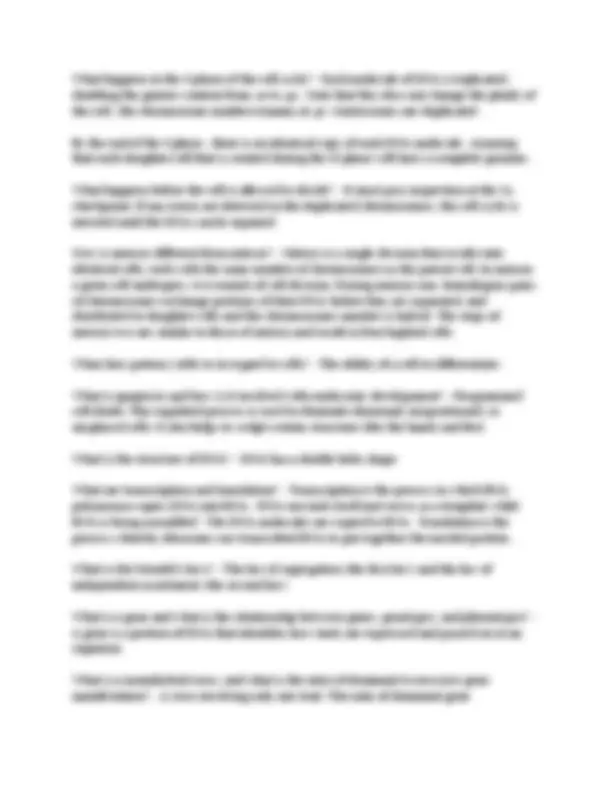
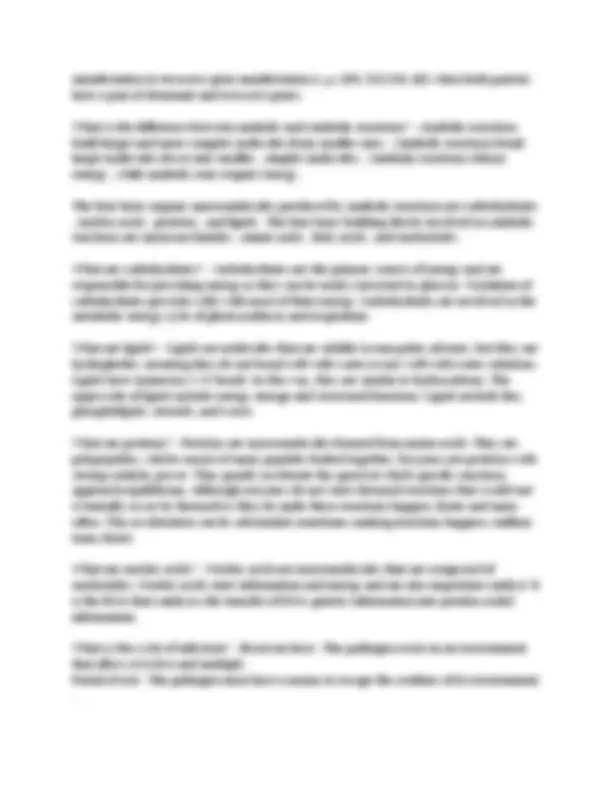
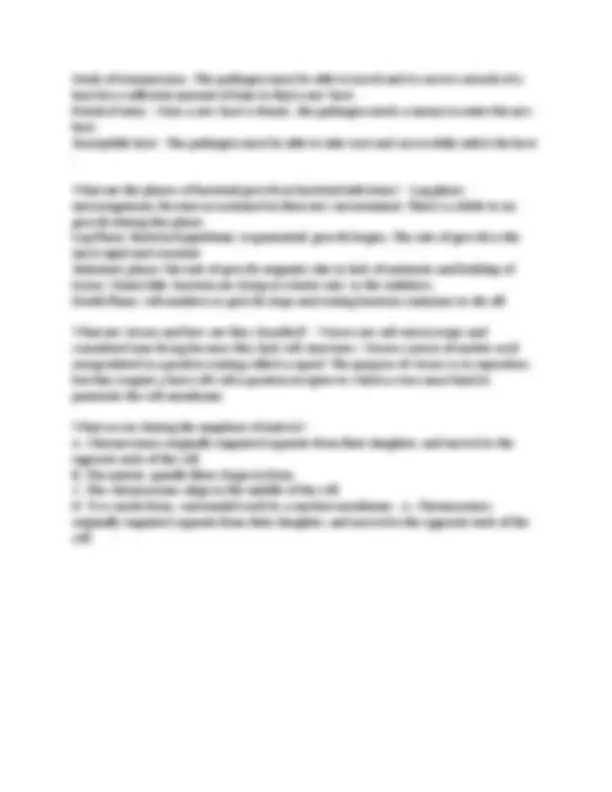


Study with the several resources on Docsity

Earn points by helping other students or get them with a premium plan


Prepare for your exams
Study with the several resources on Docsity

Earn points to download
Earn points by helping other students or get them with a premium plan
Community
Ask the community for help and clear up your study doubts
Discover the best universities in your country according to Docsity users
Free resources
Download our free guides on studying techniques, anxiety management strategies, and thesis advice from Docsity tutors
A comprehensive overview of the fundamental concepts in cell biology, covering topics such as the cell theory, the structure and function of different cellular components, cellular processes like diffusion, active transport, and cellular respiration, as well as the reproduction and division of cells. It delves into the key characteristics of prokaryotic and eukaryotic cells, the role of organelles, the mechanisms of genetic information transfer, and the immune system's defenses against pathogens. The document also explores the nervous system, the circulatory system, and the skeletal and muscular systems, providing a holistic understanding of the various systems that work together to sustain life. This resource is invaluable for students studying biology, life sciences, or related fields, as it offers a solid foundation in the core principles of cell biology and its applications.
Typology: Exams
1 / 35

This page cannot be seen from the preview
Don't miss anything!




























TEAS 7 Biology Exam Q&A Fall 2024.
cell theory - All cells arise form preexisting cells Cells can carry out the processes of life Organisms are made of cells that function together
*ANS: cell - The ____ is considered to be the basic unit of life
*ANS: prokaryotes - single cells organisms such as bacteria are examples of _____. This type of cell does not have a nucleus,but does have DNA. ALL have a cell wall
*ANS: eukaryotes - multicellular organisms such as plants and animals are examples of ______ -some have a cell wall -cell membrane present
*ANS: nucleus - The ____ of the cell is responsible for the activites of the cell regarding DNA, has its own membrane which allows for the passage of materials and proteins needed for DNA replication
*ANS: ribosomes - Responsible for the production of proteins Can be free or bound to the outer membrane of the ER
*ANS: rough endoplasmic reticulum - The ____ has ribosomes attached to the outer surface, it is also produces the proteins
*ANS: smooth endoplasmic reticulum - The _____does not have ribosomes attached and works to transport proteins out of the cell
*ANS: lysosomes - ____ are often termed "suicide sacs of the cell" because of their involvement with digestion within the cell. -besides digesting proteins, also break down parts of the cell that are no longer needed
*ANS: vacuoles - most known for their ability to store materials
*ANS: mitochondria - _____ are thought to be the powerhouses of the cell because of their ability to produce the energy needed for life.
*ANS: cristae - folds of the inner membrane of the mitochondria are called
*ANS: chloroplasts - Present in plants, contains a substance called chlorophyll to carry out the process of photosynthesis
*ANS: cytoskeleton - provides structure and shape to the cell
*ANS: cilia/flagella - these structures are not present within the cell. Instead they are located outside of the cell and allow the cell to move
*ANS: cell wall - Present in plant cells, the cellulose-containing ____ helps to give the plant cell rigidity
*ANS: diffusion - Particles naturally move from an area of high concentration to an area of low concentration this process is called ____.
*ANS: osmosis - Water can diffuse across a membrane in a process called
*ANS: Isotonic solution - concentration are the same inside and outside of the cell
*ANS: hypotonic solution, swell, burst - In a _____, the solution outside the cell has a lower concentration of solutes than the solution inside the cell.
*ANS: monosaccarides - Simplest sugars are called ____ ex. glucose and fructose
*ANS: dehydration synthesis - The combination of monosaccharides to from disaccharides and starches occurs with the removal of water via a _______
*ANS: proteins - long polymer chains called polypeptides built from amino acid subunits linked by peptide bonds.Every amino acid contains a central carbon with an amino group
*ANS: enzymes - ___ are examples of complex proteins that function to regulate the rate at which reactions occur. They are catalysts that aim to lower the amount of energy it takes for a reaction to occur
*ANS: saturated - If a fat chain contains all single bonds, the fat is classified as ___
*ANS: unsaturated - If there is a double bond in the fat chain, the fat is classified as ____
*ANS: glyercol, 3 fatty acids - Fats are each built from two components ____ and _____
*ANS: triglycerides - fats are also called ______
*ANS: nucleic acids - ___are the building blocks of DNA and RNA. -contain carbon, hydrogen and oxygen along with nitrogen and phosphorus atoms as well
*ANS: phosphate group, 5 carbon sugar, nitrogen base - Each nucleic acid contains a _____, _____ and a _____
*ANS: adenosine triphosphate (ATP) - The molecule that supplies energy for living things is called _____
*ANS: deoxyribonucleic acid (DNA) - ____is the macromolecule in cells that codes for how amino acids form proteins
*ANS: DNA - ____ is a double stranded helix that has complimentary nucleic acids that are hydrogen bonded to each other
*ANS: adenine , guanine - Nucleic acids that are classified as purines are...
*ANS: cytosine and thymine - Nucleic acids that are classified as pyrimidines are ....
*ANS: thymine, cytosine - In DNA , adenine hydrogen bonds to _____ and guanine hydrogen bonds to ____
*ANS: messenger , transfer, ribosomal - what are the three types of RNA
*ANS: mRNA,transcription - ____copies DNA's genetic code via a process called _______
*ANS: tRNA - Compliments mRNA via an anticodon that corresponds to an amino acids that it will carry
*ANS: rRNA - is found as part of ribosomes and helps in the formation of polypeptides
*ANS: mitosis - ____is the process by which most new cells are produced in eukaryotes. At the completion of this process, two new daughter cells are produced from one preexisting cell
*ANS: meiosis - Process which produces sex cells (sperm and egg) is ____
*ANS: interphase, prophase, metaphase,anaphase, telophase - Steps in Mitosis
*ANS: metaphase - ____is step in mitosis when the chromatids divide
*ANS: facilitated diffusion - Molecules cross an impermeable or semipermeable membrane down their concentration gradient , but must do so via special channels
*ANS: transcription - process of cells copying the instruction from DNA to RNA
*ANS: translation - Process of protein reduction from mRNA
*ANS: phagocytosis - endocytosis of undissolved solid matter; engulfing of pathogens of WBCs
*ANS: peroxisome - organelle used to rid the body of toxic components
*ANS: amino acid structure - Enzyme activity is drive by what internal factor?
*ANS: specific heat - Energy required to raise one unit of mass of substance by 1 degree Celsius
*ANS: cell membrane - ____is not an ogranelle , but has a lipid bilayer with both hydrophobic and hydrophilic portions
*ANS: aneuploidy - one has abnormal number of chromosomes
*ANS: pinocytosis - endocytosis of dissolved liquie molecules
*ANS: glycolysis - ___ oldest metabolic pathway, used by all cells and a precursor to both the aerobic and anaerobic respiratory pathways
*ANS: cytoplasm - glyoclysis takes place in the ______
*ANS: fermentation - IN the absence of oxygen, respiration relies on glycolysis to produce ATP in an anerobic process called_____
*ANS: homolactic, alcoholic, heterolactic - what are three types of fermentation?
*ANS: homolactic - _____ fermentation, bacteria converts pyruvate into lactic acid
*ANS: alcoholic - ____fermentation, yeast and bacteria cnvert pyruvate into ethanol and co
*ANS: heterolactic - ___ fermentation, organisms produce alctic acid as well as otehr acids and alcohols
*ANS: aerobic respiration, 36 - If oxygen is present, glycolysis leads to _____ which produces a net total of __ ATP per molecule of glucose
*ANS: krebs cycle (citric acid cycle) - Begins with acetly-CoA joining oxaloacetic acid to form citric acid.
*ANS: mitochondia, cytoplasm - The krebs cycle occurs in the ___ of eukaryotes and the ___ of aerobic prokaryotes
*ANS: genetics - _____is the study of the heredity of organisms
*ANS: gene - A ____ is the basic unit of heredity
*ANS: allele - ____ is one of two or more alternative forms of a specific gene
*ANS: heterozygous - having inherited two different alleles of a gene
*ANS: dominant allele, recessive alleles - ____ determines the phenotype in heterozygotes by masking the _____
*ANS: gametes - haploid reproductive cells , form in diploid individuals, the two alternative alleles for a gene sergate from each other
*ANS: viruses, capsid - ____ are intracellular parasites made up of a genome of double or single stranded DNA (or RNA) within a ____ or protein coat
*ANS: viral envelopes - Some viruses have ____, lipid membranes that encase the capside and assist in invading a host
*ANS: cannot - Viruses can or cannot replicate without a host?
*ANS: lytic , lysogenic - Viruses usually replicated by two cycles , ___ and ___
*ANS: evolution - ____process by which species change gradually over time.
*ANS: mutation - permanent change in a cells DNA cause diversity among individuals
*ANS: commensalism - ____a relationship in which one individual is closely associated with another and benefits without doing harm to the host
*ANS: bacteria, archaea, eukarya - what are the three domains
*ANS: endoskeleton - Humans have an ______ that supports, protects and allows for movement at the joints
*ANS: smooth muscle - ____ is found in vessels, such as the arteries,and the digestive tract, that carry fluids over long distances.
*ANS: nervous - the ____ system controls sensory input and motor output
*ANS: neuron - The basic unit of the nervous system is a ____
*ANS: digestion - ____ a process that takes approximately 24 hours, includes both chemical and mechanical means.
*ANS: chyme - In the stomach food is broken down and mixes with gastric juice to form ____
*ANS: gallbladder - bile produced by the liver is stored in the ____
*ANS: villi, microvilli - ____ and ___ increase the surface area of the small intestine and greatly increase the level of absorption of nutrients
*ANS: large intestine - Here water is reabsorbed along with vitamins
*ANS: rectum - store fecal matter before being defecated via the anus
*ANS: arteries - carry blood away from the heart are elastic and thick
*ANS: veins - return blood to the heart are thin and less elastic use valves to prevent blood backflow
*ANS: capillaries - have walls that are one cell thick to allow materials to pass through connect arteries to veins
*ANS: fat, cholesterol - A major concern regarding the American diet is the consumption of high levels of ___ and ____
*ANS: atria - the two upper chambers of the heart are called the ____
*ANS: ventricles - the two bottom chambers of the heart are called the ____
*ANS: septum - The ___ is the wall the separates the heart from left to right
*ANS: systole - the time during which the heart is contracting is called the
*ANS: passive immunity - ____ the antibodies have been obtained from outside the body, either from animal or person
*ANS: co2 - the rate at which respiration occurs is governed by the level of ____ in the body
*ANS: diaphragm - The movement of air into the lungs first starts with the movement of the ___ downward
*ANS: pharynx - connects the nasal cavity to the larynx
*ANS: ureter - The ___ is responsible for taking urine from the kidneys to the urinary bladder
*ANS: bladder - The ___ stores the urine until it is ready to be excreted
*ANS: urethra - This passageway takes urine from the bladder to the outside of the body
*ANS: hormones - The endocrine system contains a number of endocrine glands that secrete _____
*ANS: dendrites, axon - A number of branced fibers called ___ receive impulses that are carried through the ___.
*ANS: myelin sheath - The axon is covered by a fatty substance called the ___
*ANS: synapse - Nerve impulses reach a gap between neurons called a ____ where neurotransmitters cross the gap and transmit the impulse another neuron
*ANS: sodium potassium pump - Nerve impulses travel at high speeds and are conducted via a _____
*ANS: central nervous system - The ______ is composed of the brain and spinal cord
*ANS: brain - the ___ is composed of the cerebrum, cerebellum and medulla oblongata
TEAS 7 Biology Exam Q&A Fall 2024.
*ANS: cerebellum - controls voluntary movements and some involuntary movements
*ANS: medulla oblongata - responsible for involuntary movements
*ANS: peripheral nervous system - The ____ is composed of sensory neurons that transmit nerve impulses toward the CNS along with motor neurons that transmit impulses from the CNS
*ANS: somatic nervous system - guides the actions of skeletal muscles
*ANS: autonomic nervous system - guides the actions of organs and involuntary muscles
*ANS: parasympathetic nervous system - guides the actions of the body that calm the body down
*ANS: autonomic nervous system - controls actions that raise the body's level of activity
*ANS: marrow - the ___ of the bone is where RBCs are formed along with WBCs
*ANS: cartilage - ___ is flexible but serves the sme purpose as bone, allows for some degree of movement so that bones can bend easily at joints.
*ANS: adaptation - ncrease from generation to generation of allels of genes that allow a species to survive in their environment
*ANS: acid - Any compound with hydrogen ion activity greater than water
*ANS: b cell - type of lymphocyte that produces antibodies in response to antigens; responsible for humoral immunity
*ANS: antibody - protein produced by a B cell in response to an antigen
*ANS: base - any compount with a hydrogen ion activity less than water
*ANS: catalyst - substance that controls the rate of a chemical reaction
*ANS: cytoplasm - rich protein fluid with gel-like consistency housing organelles
*ANS: germ cell - a gamete(sperm or oocyte precursor)
*ANS: mass - Matter is anything that has ...
*ANS: hormones - chemical regulators in blood
*ANS: atoms - smallest units of matter
*ANS: catabolism - breakdown of complex chemical substances
*ANS: anabolism - synthesis(building up) of complex chemical substances
*ANS: cell - smallest functional unit of an organism
*ANS: abdomen - portion of body between diaphragm and pelvis
*ANS: adrenal glands - endocrine glands located on the superior portion of the kidneys are called
*ANS: one - pyrimidines have only ___ ring
*ANS: 2 - purines have ___ rings ex. guanine and adenine
*ANS: at gc - DNA sequence of nitrogenous bases?
*ANS: transcription - process of cells copying the instruction from the DNA into the RNA
*ANS: carbohydrates - Breakdown of what begins in the mouth?
*ANS: protein - Breakdown of what begins in the stomach?
*ANS: sympathetic nervous system - Which of the following nervous systems directs the body's fight-or-flight response
*ANS: cardiovascular - Which organ system supplies the body's cells with oxygen and nutrients
*ANS: pulomonary artery - Through which does blood pass after leaving the right ventricle during contraction of the heart
*ANS: smooth muscle - Which type of tissue is responsible for the peristalsis that occurs in the digestive tract
*ANS: alveoli - Exchange of oxygen occurs in which structure of the respiratory system
*ANS: higher - Fertility rates are ________ in less-developed countries than they are in more-developed countries
*ANS: membrane bound nucleus - Prokaryotic cell lacks a ______
*ANS: agglutination - What is the term for when blood of two different types clumps because of different antibodie
*ANS: emulsion - What is it called when two liquids cannot mix and are suspended
*ANS: axon - What part of the nerve cell that carries impulses away from the cell body and connects the neuron with another neuron over a synapse
*ANS: genome - Complete set of DNA for an individual; contains all genes
*ANS: nucleoid - Region of prokaryotic cell where the cell's DNA is located (not enclosed by a membrane). Condensed DNA of the cell.
*ANS: plasma membrane - In prokaryotic cells, _______ is the membrane enclosing the cytoplasm
*ANS: eukaryotic, prokaryotic - _____ are larger and more complex than
*ANS: plasma membrane - In an eukaryotic cell: what is the membrane that envelopes the cell and is semipermeable to allow certain substances and water in and out
*ANS: chloroplast - what is used to carry out photosynthesis?
*ANS: surface - The ______ of an eukaryotic cell is called the cell membrane.
*ANS: chromosomes - What is the condensed, single, very long strands of DNA double helix located in the nucleus of a cell containing hundreds of genes
*ANS: DNA - The central dogma of biology states that ____ gives rise to RNA, which gives rise to protein
*ANS: zygote - What is a mass of cells formed after an egg is fertilized and begins dividing
*ANS: embryo - What is an early development of an animal or a plant after fertilization
*ANS: amino acids - A chain of _____ results in a protein